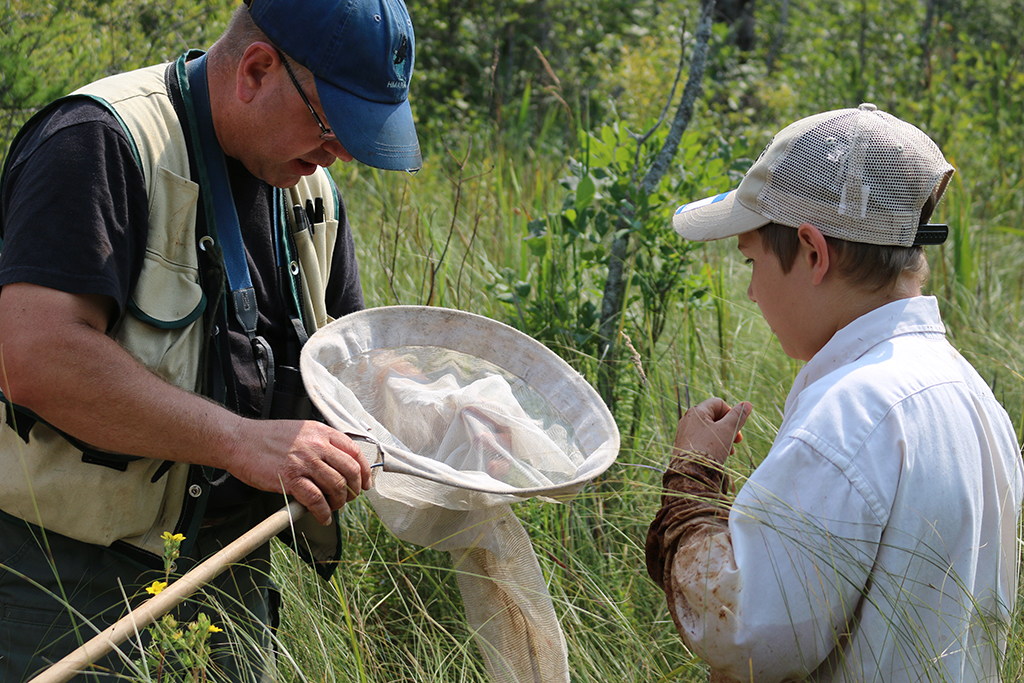Feature
Place-Based Education
Connecting to STEM Learning Experiences
Connected Science Learning July-September 2018 (Volume 1, Issue 7)
By Sarah Waters, Brandon Schroeder, and Tracy D'Augustino
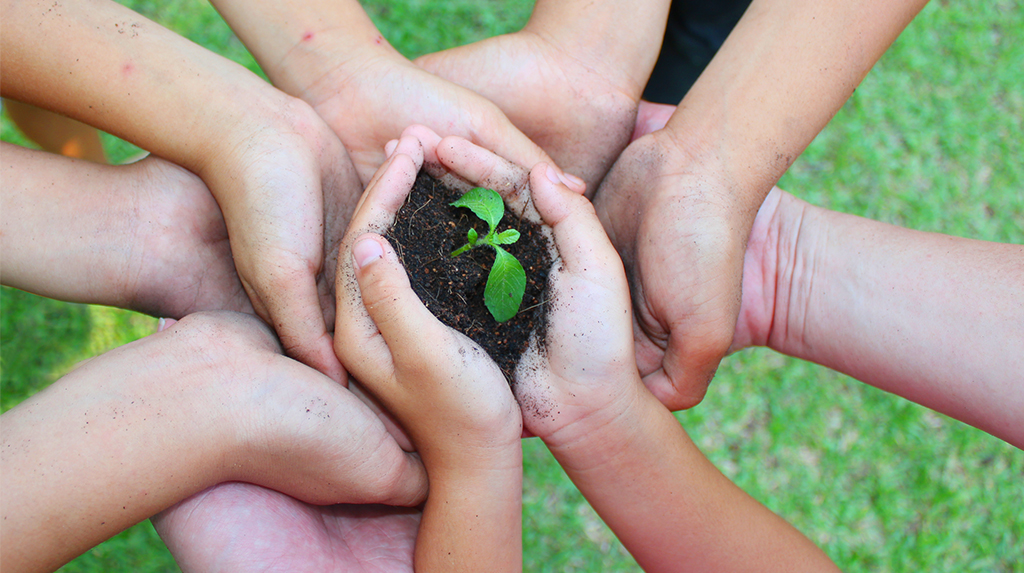
The Great Lakes Stewardship Initiative (GLSI) is a statewide network in Michigan that promotes rigorous place-based education experiences for K–12 students. This article focuses on the Northeast Michigan GLSI (NEMIGLSI)—one of nine regional GLSI hubs—and uses case studies to illustrate how PBE can accomplish Great Lakes Literacy goals (Fortner and Manzo 2011) and provide environmental science, technology, engineering, and math (E-STEM) opportunities. Facilitated by Michigan State University Extension, Michigan Sea Grant, the National Oceanic and Atmospheric Administration’s Thunder Bay National Marine Sanctuary, and other leadership partners, the NEMIGLSI network empowers youth to be valued partners in protecting our Great Lakes and natural resources through hands-on learning in and with their rural communities.
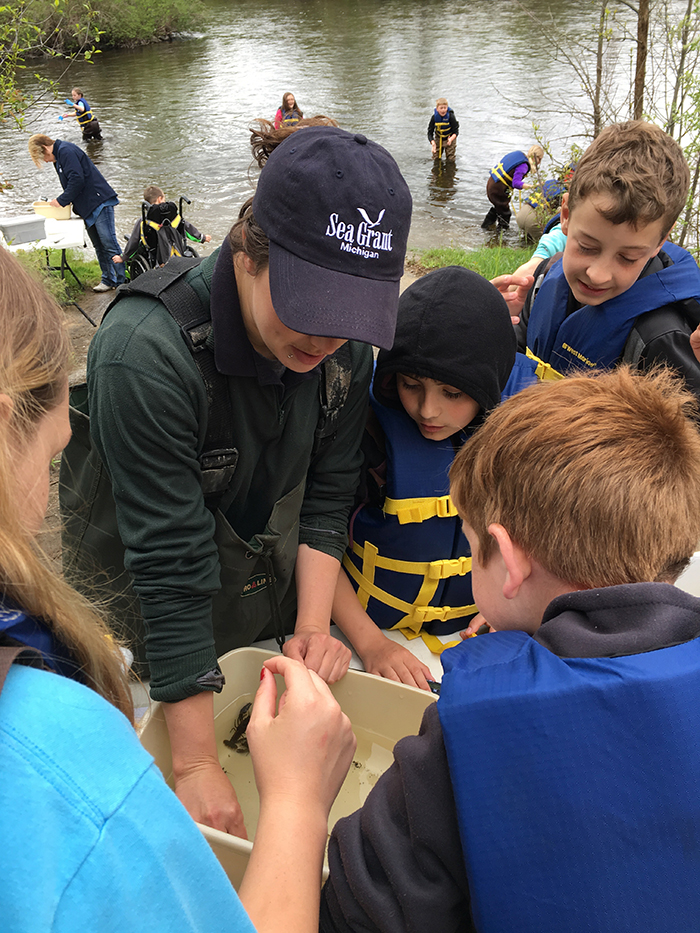
Credit: NEMIGLSI
A focus on place-based education
Place-based education (PBE) is a process that connects students with their local environment by addressing real community issues while meeting education requirements. As an instructional strategy. Meaningful PBE brings together three things in a meaningful way: (1) student achievement, (2) environmental protection and stewardship, and (3) community vitality. PBE can provide experiences that are relevant to students’ lives and local context, offering students the opportunity to gain and apply knowledge through firsthand experiences and collaborative work with others in community. The NEMIGLSI network plays an important role in these projects by:
- facilitating school–community partnerships,
- providing sustained professional development for educators and community partners, and
- directly supporting innovative, collaborative, student-driven PBE projects.
NEMIGLSI network’s educational strategy is framed in national place- and community-based literature, research, and best practices (Smith and Sobel 2010; Woodhouse and Knapp 2000; Yoder 2012; Demarest 2015).
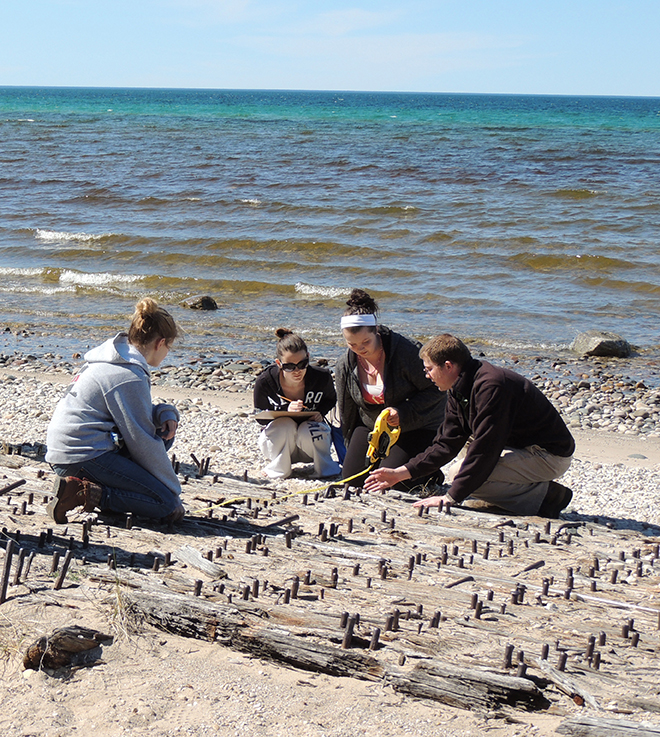
Credit: NEMIGLSI
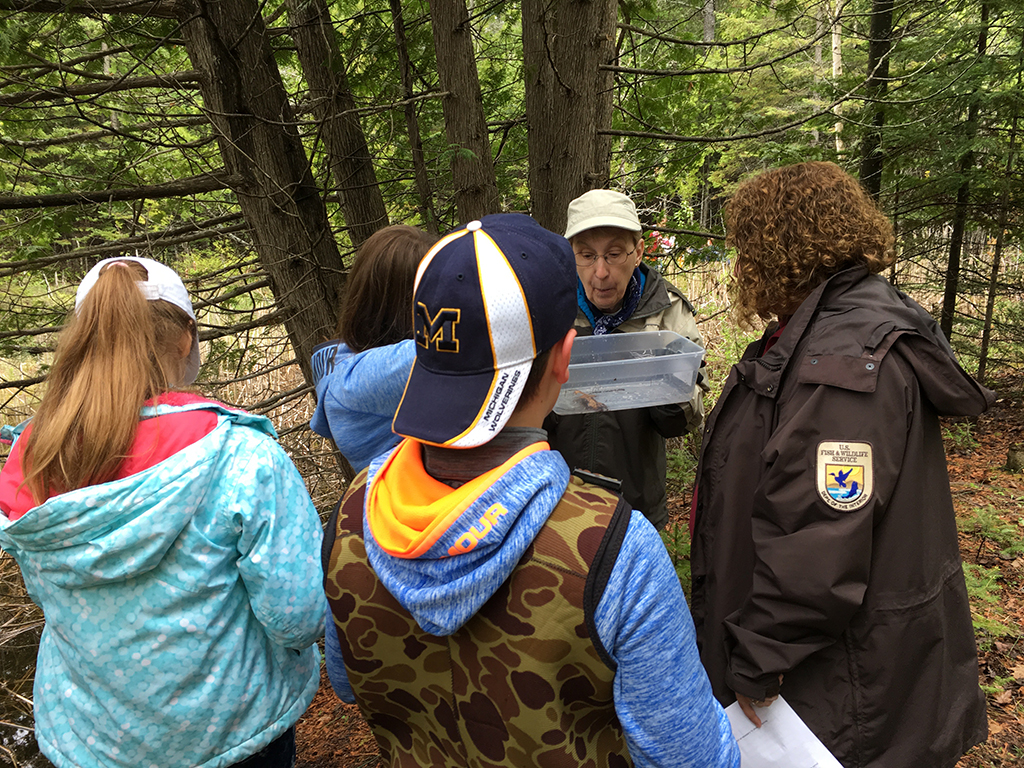
Credit: NEMIGLSI
Connecting citizen science and place-based education
We overlay PBE learning strategies with applied STEM experiences (Schroeder et al. 2016), thus positioning youth as leaders and contributors among a diversity of projects and opportunities. Some of these include citizen science experiences, in which members of the public collect data for use by scientists. These activities allow students to contribute to research, monitoring, and a better understanding of our natural resources. Citizen science programs also often feature simple protocols for registering, implementing, and reporting research and findings, making them both teacher- and family-friendly. In northeast Michigan, teachers, 4-H educators, and informal educators (e.g., museums, visitor centers) have collaborated since 2007 on citizen science STEM learning using the PBE framework by partnering through the NEMIGLSI network. Many of these regional, national, or global citizen science projects (such as Adopt-a-Beach, Monarch Watch, and iNaturalist) were unknown in northeast Michigan until NEMIGLSI network students took on the projects. Local student involvement often inspired other schools and community groups to get involved. For example, there are now many new Adopt-a-Beach sites in northeast Michigan, a new trend resulting from student-inspired projects. In this way, students are leaders in inspiring these citizen science values and opportunities among our northeast Michigan schools and communities.
A wealth of existing citizen science projects, such as the Alliance for the Great Lakess Adopt-a-Beach program, University of Kansas’ Monarch Watch, and the online iNaturalist biodiversity mapping project, have been adopted by classrooms across our NEMIGLSI network because they also align with classroom learning or school improvement goals. These existing projects can be used as standalone opportunities or together with PBE projects designed by students with their teacher. For example, one network school started a pollinator garden project on its campus and during the planning phase, they began using Monarch Watch with kindergarten classes. Combining Monarch Watch with garden explorations around the community allowed the school to meet Next Generation Science Standard K-LS1-1: Use observations to describe patterns of what plants and animals (including humans) need to survive (NGSS Lead States 2013).
Our network and partnerships are less focused on promoting specific projects with schools, and more about encouraging schools and educators to seek citizen science project opportunities that align with school learning goals; connect youth with the Great Lakes science community; serve a value in the local community context; and are exciting, meaningful, and engaging for the youth.
Students have locally conserved Lake Huron’s biodiversity, mapped threatened and endangered species habitats, restored native fisheries, monitored vernal pools, preserved cultural resources, and cleaned up marine debris alongside Great Lakes scientists and natural resource professionals. These projects helped students address critical Great Lakes and local environmental issues—and at the same time, students learned important content as part of their regular school curriculum. Many of these projects were launched as a result of citizen science connections that schools and educators have made with the Great Lakes science community, and they have rather organically grown into afterschool and informal education opportunities.
Evaluation of our efforts
Our network used an evaluative case study to highlight how PBE strategies can foster environmental stewardship and civic engagement among youth (Gallay et al. 2016). In responding to the questions, “What did you most value about the project?” and “Anything else you would like us to know concerning your opinions about the stewardship project, or learning about the environment, or how the stewardship project affected you personally?” many students referenced the human community (n = 87; 32%); that is, people or members of the public who would benefit from their work. One student stated, “The thing I most valued is the fact that the beach is going to be clean for this summer, that way more people will enjoy it.” Students also mentioned benefits to the environmental commons (natural resources accessible to all members of a society and held in common, such as air and water) and nonhuman species (n = 75; 27%). For example, one student said, “What I valued most about our stewardship project was the fact that we helped the environment and now it is cleaner for the wildlife.” Another 20% (n = 56) of the responses referred, in general, to making a difference through their actions without specifying human or nonhuman species as beneficiaries, such as the student who wrote, “Knowing the water is clean, that is what makes me happy or proud” (Gallay et al. 2016).
A Michigan Sea Grant evaluation report, Place-Based Education: Engagement From the Student Perspective (Rote, Schroeder, and Augustino 2015), documents that our students value PBE experiences because they are hands-on, engaging, community-connected, career-oriented, and fun. In the open-ended written surveys administered to students, “fun” was the most common answer to the questions “Why should students take this science class?” and “Why did you choose to take this class?” Without being prompted or offered options, 32.69% to 37.65% of students used the word “fun” as they answered these questions.”
Rote et al. (2015) later explained that “fun” became a catchphrase for activities and projects that were both meaningful and actively engaged in “doing.” This concept of “doing” signifies more than just hands-on activities; it means actively engaging students’ bodies and minds in a purpose-driven endeavor. In analyzing the data, we determined that students describe something as “fun” when the three goals of place-based education—student achievement, environmental protection and stewardship, and community vitality—come together in a meaningful way. “Fun” for place-based education means actively doing something, with purpose, in the community. In terms of hands-on learning, a sixth-grade student compared her place-based class to her previous science class. She said, “In science last year, we never went on a field trip. We just did boring science and we hated it. But this year we actually get to do hands-on activities and it’s so fun” (Rote, Schroeder, and Augustino 2015).
Advice from years of our PBE work
Over the years, the evaluation of our efforts has resulted in the following seven pieces of advice, which can help others get started with place-based education:
- Explore a wide variety of locally relevant citizen science options through a place-based education lens.
- Start simple and grow into opportunities.
- Feature youth voices.
- Look to your community partners for potential projects.
- Seek out educational values in the data your students collected.
- Gain a global perspective through your local findings.
- Raise interest and awareness about regional (such as Great Lakes) issues through public outreach. Share your projects and findings with your community.
1. Explore options
PBE frames questions in the context of local, environmental, and community needs. There are two main approaches to designing and implementing a PBE project. The first approach begins without an identified issue. Either in the classroom or after school, students brainstorm local problems by reading local newspapers and community social sites, looking for areas of concern. They can also ask local civic groups or public land managers about the issues they have already identified. This approach allows youth to learn about the different organizations and agencies that support their community. Once a list of issues is developed, teachers need to look for connections to their educational requirements.
PBE is only sustainable in a school setting when it connects with state- and district-required learning to ensure support from administrators. When the list has been reduced to concerns that connect to the required learning, return the list to students. PBE is most effective when it is youth-driven. Ask students to explore potential solutions to the problem or opportunities to be a part of the research.
In the second approach, the teacher or a community partner has already identified an issue, such as trash on the beach, invasive species, or habitat health. This method is often best suited for younger students and afterschool opportunities. Depending on students’ age, teachers may introduce the problem along with the solution or encourage youth to discover the solution through strategic questioning and research.
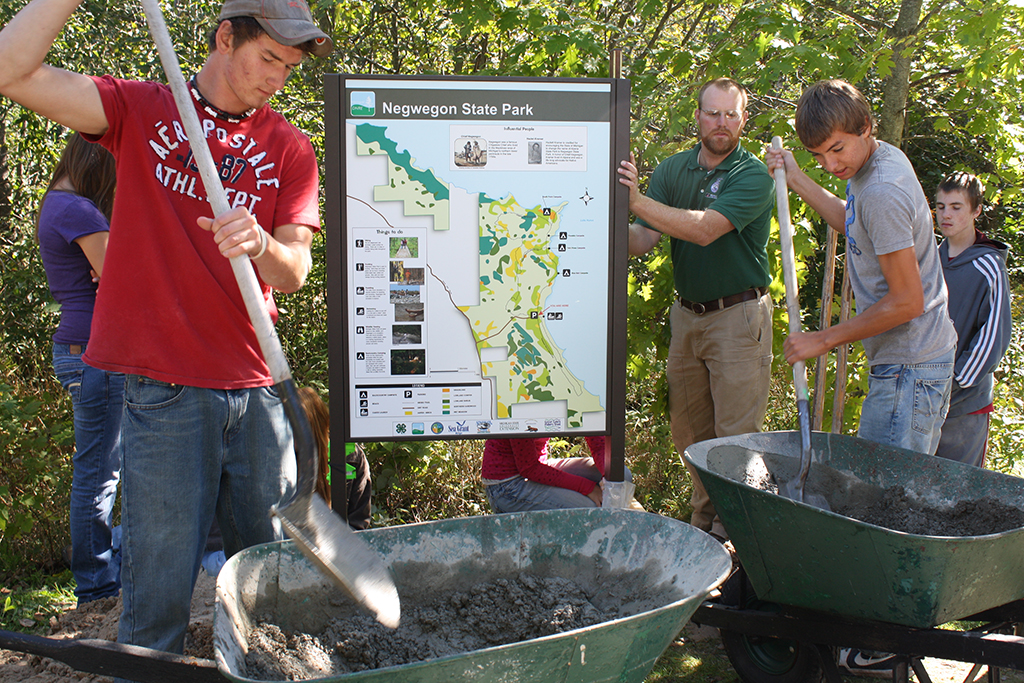
Photo credit: NEMIGLSI.
Case study
A Michigan Natural Features Inventory researcher expressed a need for citizen help in looking for suitable habitat for the threatened Hines emerald dragonfly. The request was passed along by the Department of Natural Resources to a teacher and then to a local 4-H club, which took on this citizen science project of searching the park and documenting potential habitat for this threatened species.
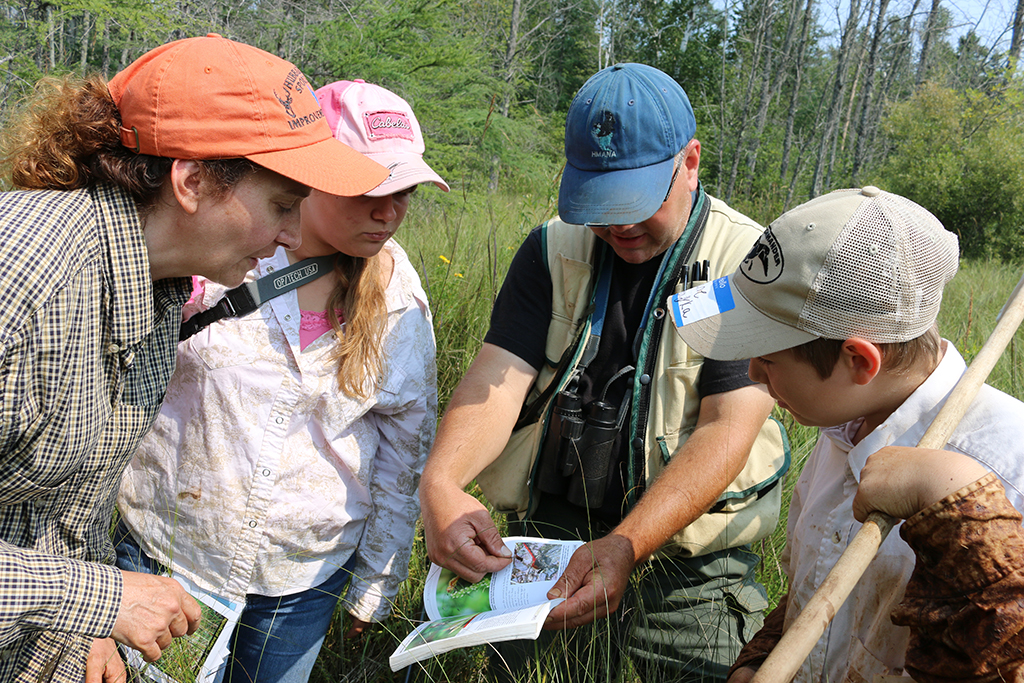
Credit: NEMIGLSI
2. Start simple and grow into opportunities
Established programs can be a great way to get started with a PBE project. These monitoring efforts can lead to future in-depth studies and opportunities. In these cases, citizen science protocols are typically already in place, so less work is needed to connect your students to the effort. You just need to identify an area of interest and see whether there are citizen science opportunities available. Some established programs include iNaturalist, the Great Backyard Bird Count, and Monarch Watch. Additional projects can be found on the SciStarter website.
Case study
Many PBE and citizen science projects arise from an individual or group’s interest in and knowledge of an existing opportunity. An Alpena middle school teacher and 150 students started with the established Adopt-a-Beach clean-up, an existing citizen science program coordinated by the Alliance for the Great Lakes. Students identified the ultimate goal of stopping marine debris from ever being a problem in the first place, and began by removing debris from local beachfront parks and recording the type and weight of litter they found. The collected data were added to the Alliance for the Great Lakes database, and mapped to reveal locations with common litter problems across the Great Lakes. Excited by the efforts of the middle school students, other local youth formed an afterschool club through 4-H and began a local public awareness campaign about the issue of marine debris.
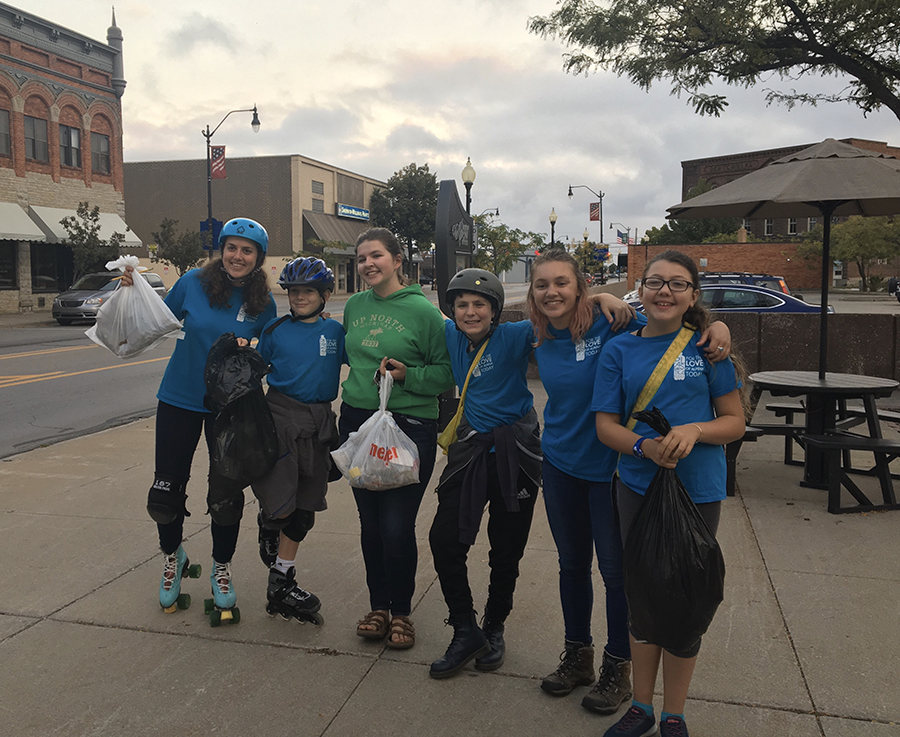
The Alpena middle school teacher faced a common problem in middle and high schools—limited time and a large number of students. The Adopt-a-Beach program was a great way for her to engage all of her students and provide them with opportunities to collect data and participate in rich scientific conversations back in the classroom. This teacher used the data to discuss the movement of water along the coast and through the city, the impact of humans on both the land and water, and changes to the land due to human activity and water movement.
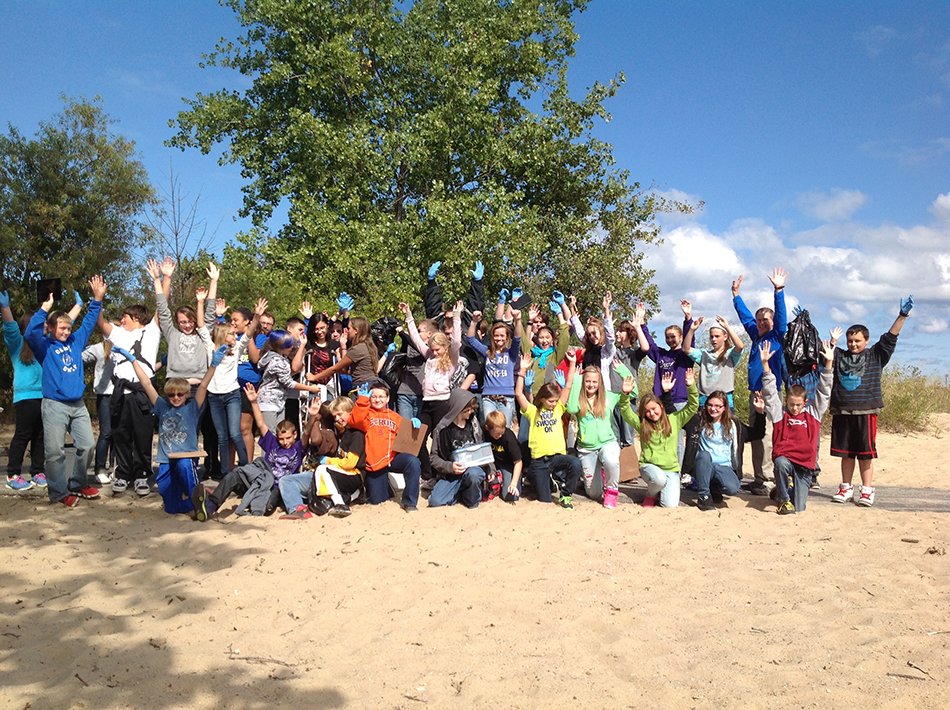
Credit: NEMIGLSI
3. Feature youth voices
Establish and document a clear role for students in exploring, selecting or designing, and locally delivering the citizen science project. In 2012 Jon Yoder (a former teacher) authored Connecting Classrooms to the Community, which includes examples and lessons to get youth and their communities involved in exploring issues and selecting projects relevant to their local place and community. Examples of youth voice can be found throughout the PBE efforts detailed in this article.
Case study
Through the Alpena middle school Adopt-A-Beach cleanup and data analysis, students discovered that a large percentage of the trash on beaches was composed of cigarette butts. Outraged by this discovery, students asserted their voice by enlisting the help of their teacher to reach out to their city council and mayor. During a city council meeting, students reported the problem using their data. They also suggested solutions, such as putting cigarette receptacles at the city beaches. The mayor later visited students in their classroom to report that not only was the city going to purchase the suggested receptacles, but it had also passed an ordinance making it illegal to smoke on the city beaches.
4. Look to your community partners for potential projects
Both teachers and informal educators in the NEMIGLSI network recognize that local, organically developed projects can guide great citizen science experiences. They often identify local scientific research or restoration efforts within their community to get started. Students are often found working alongside a diversity of research and resource experts, supporting existing projects or even receiving support for their own youth initiative or research project. Regardless of the research or investigative project, youth are valued as citizen science contributors and are well-supported by a network of locally present science and research experts—a tremendous science career exploration and mentorship value.
Case study
Students began exploring their local public lands after connecting with researchers and volunteers from the Michigan Natural Features Inventory (MNFI). One MNFI project, Vernal Pool Patrol, focuses on monitoring and identifying vernal pools. Classrooms in AuGres, Roscommon, and Alpena, Michigan, have been able to identify vernal pools on their school grounds or in walkable public areas near their schools, and 4-H clubs have taken on vernal pool monitoring further afield in local state parks. In both cases, students fulfill a monitoring protocol with the help of volunteers and agency partner staff in the spring and fall each year, contributing their local data to the statewide MNFI database.
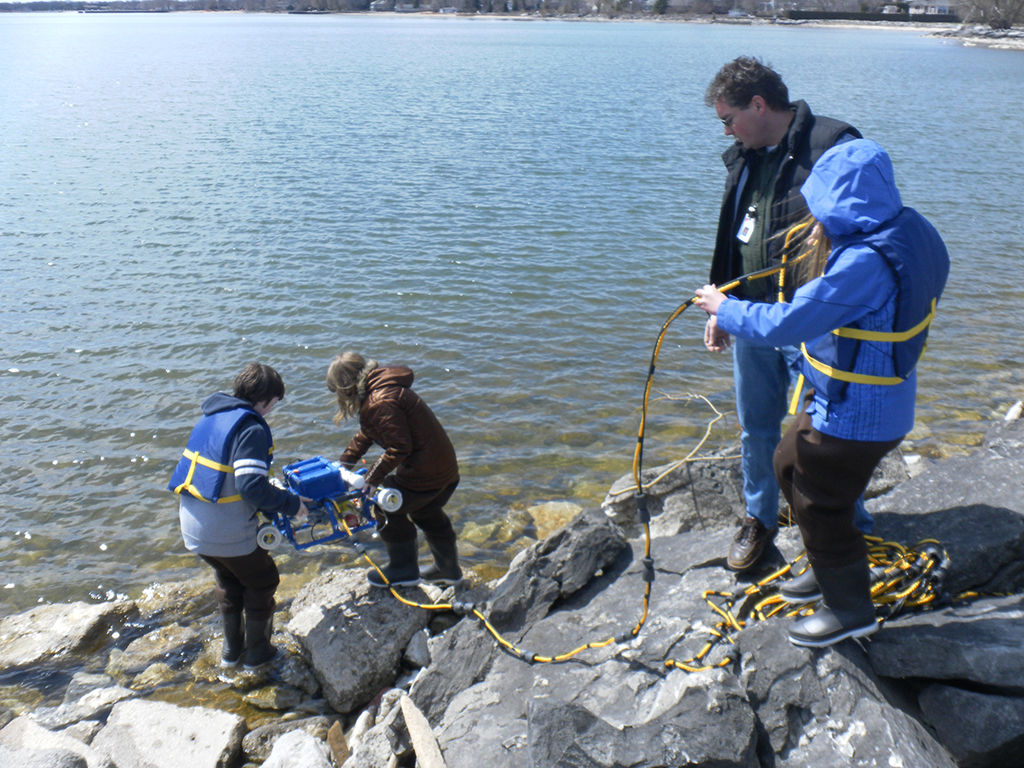
Credit: NOAA, Thunder Bay National Marine Sanctuary
5. Seek out the educational values in the data your students collected
Typically, participants in established citizen science programs report findings to a researcher or organizational partner leading the citizen science project or to an online database; but science learning need not end there. Supporting student analysis and communication about the data they collect is a great way to immerse students in the process of science. This may also enhance inquiry-based learning opportunities about locally relevant natural resource topics and issues.
Case study
When several teachers at Au Gres-Sims school, part of the NEMIGLSI PBE network, decided they wanted to take on a citizen science project that could extend over multiple years, help the local environment, and generate data to use in the classroom, they looked to community partners to take students to a nearby island preserve struggling with an influx of invasive species. Huron Pines and Saginaw Valley State University became lead partners, with Huron Pines aiding in the controlling of the invasive species and Saginaw Valley analyzing genetic diversity from specimens collected by students. Now, three years into the project, students continue to identify, map, and measure invasive species, sharing this information with their partners. Students also discuss the data they collect, graphing and comparing the data each year with past years to determine the effectiveness of the controls used by Huron Pines. Learning to identify invasive species and native threatened species has provided a springboard for additional classroom learning opportunities.
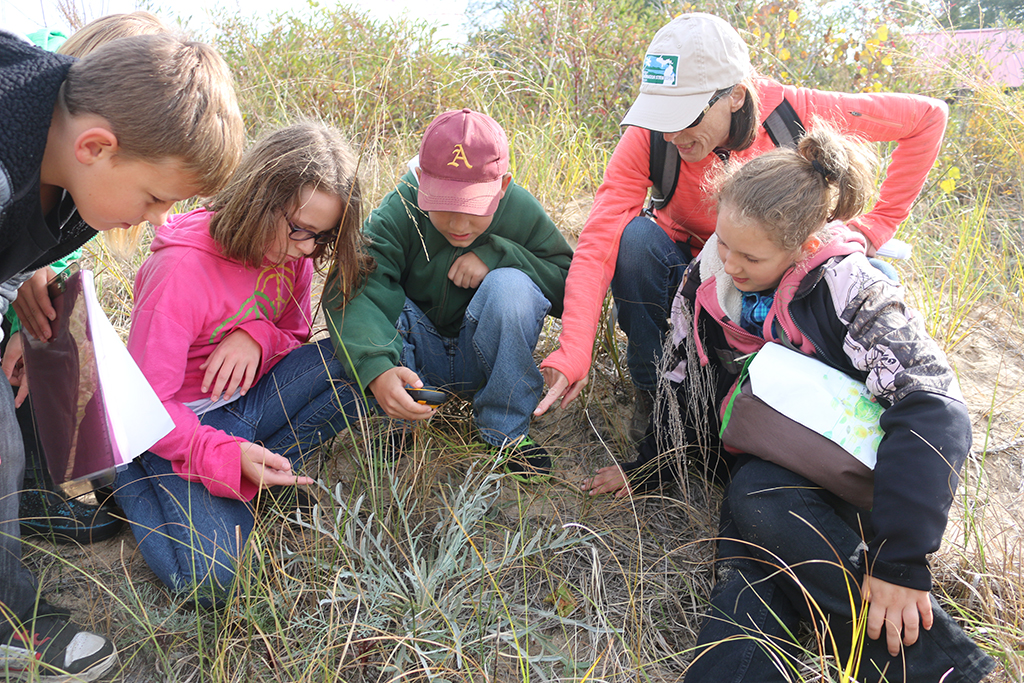
Credit: NEMIGLSI
6. Gain a global perspective and connections through your local findings.
Citizen science participants, by definition, are part of a collaborative project with professional scientists. Although many projects have a large-scale focus, they depend on reliable local data. Youth can focus on a global-scale issue by collecting data locally through statewide and regional partners and programs.
Case study
In recent years, population levels for monarch butterflies have dropped immensely, causing serious concern for both biologists and butterfly lovers alike. To monitor and track their migration, scientists work with schools and community members to promote a citizen science tagging effort. Youth from Alcona Elementary School mark butterflies using a very small identifying sticker, and then they record data related to each butterfly. Butterflies are then released to continue their migration to Mexico. When the marked butterflies are recaptured, scientists can learn a great deal about survival, population health, and migration patterns. This citizen science project led by Monarch Watch also offers a hands-on educational opportunity to learn about monarch butterfly habitats, life cycles, and migratory patterns—while contributing to science.
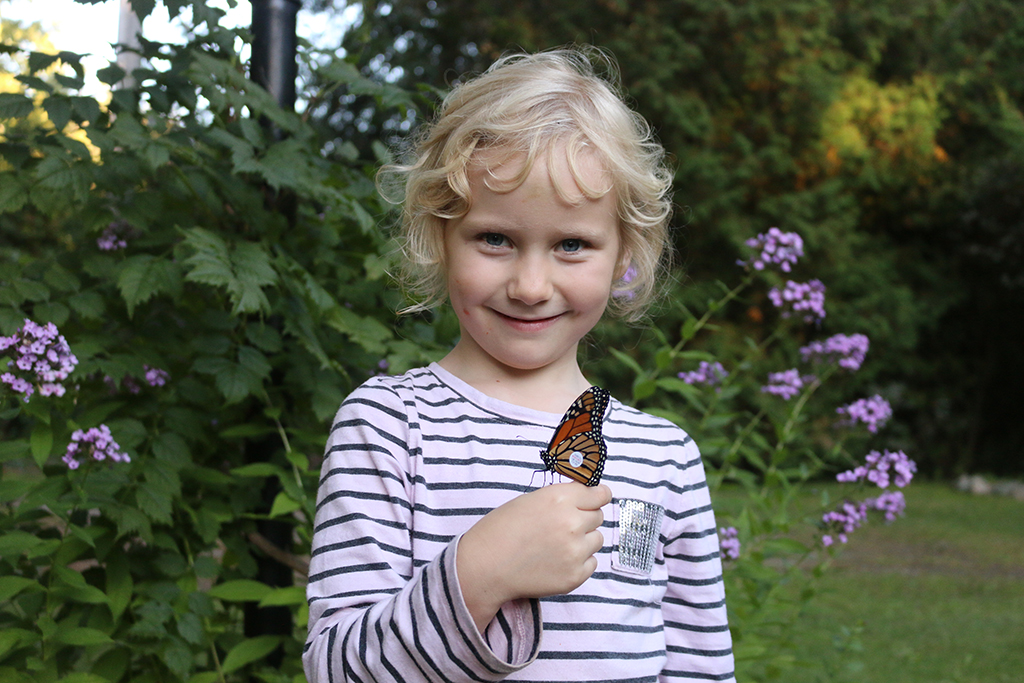
Credit: NEMIGLSI
7. Raise interest and awareness through public outreach
Through these PBE projects, students raise awareness among the public about complex issues. Community members and media often take note when students get involved. This connection offers a great opportunity for youth to communicate about topics or issues important to them.
Case study
After reading about invasive species in the Great Lakes, Ella White Elementary school students traveled to their local river to investigate what different invasive species might be present. As a part of this effort, students used nets to trawl for microplastics, a human-made “invader,” and interpreted their results in the classroom. Surprised by the plastic fibers they found in the water, students wanted to share this information with their community by developing a film about the issue and solutions to the problem.
Before filmmaking, students researched the topic of marine debris and found that microplastics are a problem in both our Great Lakes and oceans. Students consulted with fisheries and microplastics experts to verify their findings. Next, students outlined the film’s goals and created a storyboard. Students also crafted props, recorded audio, and captured video footage.
The Northeast Michigan Earth Day Bag Project, an effort through which third-, fourth-, and fifth-graders learn about the harms of and solutions to single-use plastics pollution in our Great Lakes and oceans, used the film as an educational tool. After watching Plastics 101 and discussing the information, students across northeast Michigan decorated paper bags with conservation messages, which were distributed to customers at local grocery stores on Earth Day. These collective efforts allowed students’ findings about plastics in their local river to be shared across a wide audience.
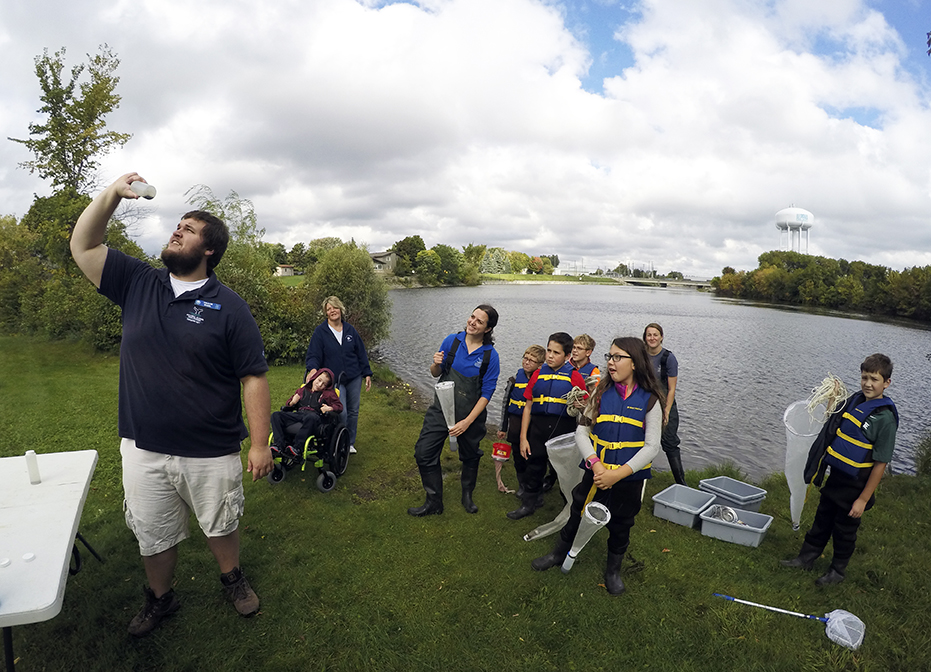
Credit: NEMIGLSI
Guiding principles for place-based stewardship education
To support these ongoing educational efforts in northeast Michigan and other state network hubs, the GLSI, with support from the Great Lakes Fishery Trust, developed a PBE framework, including guiding principles and a rubric to help guide teachers, partners, and students in efforts that often use citizen science as a tool for learning. These new Guiding Principles for Exemplary Place-Based Stewardship Education include a set of principles codeveloped by the GLSI hubs, with support from the U.S. Environmental Protect Agency, and reviewed by six national experts. The principles are now being enacted by all GLSI hubs across the urban–rural spectrum. The principles and other knowledge products associated with them, along with the work supported by the NEMIGLSI and other GLSI hubs, help describe and bring to life a pedagogical strategy and evidence-based best practices that can powerfully engage and develop students as knowledgeable, effective partners in Great Lakes stewardship.
PBE offers a framework through which students can contribute to real-world, meaningful citizen science efforts through their learning and leadership at school and after school in their communities. PBE and citizen science are grounded in STEM learning. The opportunities shared here were selected from a wide variety of efforts from a regional network of teachers and informal educators that describe a place-based education strategy that lies not in the details of a specific citizen science project, but rather in the instructional process and school–community partnerships. This is all centered on engaging youth, through their learning, in environmental stewardship projects that are real and relevant in their local context. In this way, a variety of potential citizen science partners and projects are made available to educators and students, allowing choice and flexibility in projects that are exciting, age-appropriate, and a good fit for targeted learning goals. Citizen science opportunities are a great way to get everyone involved.
Sarah Waters (sarah.a.waters@noaa.gov) is education and outreach coordinator at the Thunder Bay Marine Sanctuary in Alpena, Michigan. Brandon Schroeder (schroe45@anr.msu.edu) is a Sea Grant extension educator in Northeast Michigan with Michigan State University Extension. Tracy D’Augustino (daugustt@anr.msu.edu) is a science educator with Michigan State University Extension.



